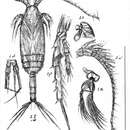en
names in breadcrumbs


Female: cephalothorax has an elongate oval shape, over 2.4 times longer than wide. The third segment of the exopodite of P1 and P4 with spines on the back surface. The 2nd segment of the endopodite of P2 without an outer chaeta. The last thoracic segment is short and its posterior corners are not transformed into lobes.
Male: P5 biramous, the protopodite of the left leg is larger than the one on the right. Spines on the 1st segment of A1 form a row. The basipodite of the right P5 reaches the distal half of the basipodite of the left leg.
Cosmopolitan species
Oceanic, meso- to bathypelagic species.
Female:
Cephalothorax has an elongate oval shape, about 2.4 times as long as wide. The head end is smoothly rounded. From side view the back narrows toward the ventral side starting from the middle of the head. The 4th and 5th thoracic segments are separate or partially fused laterally, the posterior corners of the last thoracic segment are widely rounded. None of the thoracic segments carry lateral spines. The cephalothorax is 3 times longer than the abdomen. The genital segment is slightly longer than wide, the ventral projection is large, as thick as half of the next abdominal segment. Its posterior part is massive, overhangs the next segment. Caudal rami 2 times longer than wide and symmetrical. Supra-anal plate carries a row of long hairs.
- A1 is 4 last segments longer than the body. Exopodite segment 1 with 1 or 2 chaetae, segment 2 with 2. The distal edge of endopodite segments 1 and 2 with a row of chaetae.
- The feeding edge of Md with 4 tall and 4 smaller and more densely placed teeth and chaeta.
- The coxopodite and basopodite of P1 with rara small chaetae, the inner edge with hairs. The segments of the exopodite with long outer spines, which extend beyond the base of the next spaine. The endopodite with 2 inner chaetae.
-The second segment of the exopodite of P2 with 1 row of short spines on the back edge; the third segment carries 3 rows of spines. The second segment of the endopodite with 2 rows of spines and no outer chaeta.
-The bottom surface of the second segment of the exopodite of P3-P4 has a proximal tow of 8-9 wide, flattened spines, and a distal row of 5-6 spines.
Male:
Cephalothorax egg-shaped from dorsal view. From side view back is convex, the front and back ends are smoothly rounded. The head and 1st segment, 4th and 5th segments incompletely fused. The back corners of the third thoracic segment protrude slightly. Cephalothorax 1.7 times longer than the abdomen.
A1 reach the middle of the 2nd abdominal segment. The coxopodite of P4 with spines on the outer surface, lacks an inner chaeta. P5 biramous, reaches the second abdominal segment. The left protopodite is longer than the right, the left exopodite is longer than the right by half of the distal segment. The right endopodite is longer and thinner than the left. The left endopodite reaches the middle of the third segment of the exopodite,
Female: 0,83-1,98 mm
Male: 0,90-1,22 mm